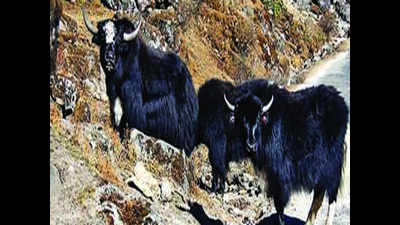- News
- City News
- guwahati News
- Yaks find a home in Arunachal, Sikkim; numbers down elsewhere
Trending
This story is from October 27, 2019
Yaks find a home in Arunachal, Sikkim; numbers down elsewhere
Yaks have registered an increase in population in Arunachal Pradesh and Sikkim even as their numbers in other hill states in the country declined, the 2019 livestock census has found.

In Arunachal Pradesh, yaks are concentrated in West Kameng and Tawang districts.
GUWAHATI: Yaks have registered an increase in population in Arunachal Pradesh and Sikkim even as their numbers in other hill states in the country declined, the 2019 livestock census has found.
The ministry of fisheries, animal husbandry and dairying's livestock census 2019 said the overall yak population in the country is an estimated 58,000, which is a significant drop of 24.67%, compared to the previous census conducted in 2012.
Yaks are confined in the high altitude terrains of Arunachal Pradesh, Jammu and Kashmir, Himachal Pradesh, Sikkim, and West Bengal.
In 2012, the yak population in these states was estimated to be 77,000.
In Arunachal Pradesh, yaks are concentrated in West Kameng and Tawang districts. Yaks in Arunachal Pradesh are recognised as a distinct breed by the Karnal-based National Bureau of Animal Genetics Resources (NBAGR) because of characteristics different from yaks found in other states. Known as Arunachali yaks, they are characterised by their predominant black body colour and high fat content in milk up to 7.45%. It said a lactating Arunachali yak produces an average of 1.3 kg milk per day, which is comparatively poor quantity, but it is compensated by high fat content for producing different milk products.
In 2003, there were an estimated 9,000 yaks in Arunachal Pradesh.
Sikkim has recorded 29.31% population growth of yaks. Yak population in Sikkim has increased to 5,219 in 2019 from 4,036 in 2012. Sikkim lost about 300 yaks in Muguthang due to starvation after heavy snowfall in December last year cut off supply routes to the area. The casualties could only be assessed after the snow melted and veterinary team reached to the interior pockets of the high altitude area.
In contrast to Arunachal Pradesh, yak population has dropped more than half in Jammu and Kashmir. From 54,493 in 2012, yak population in the state has come down to 26,221 in 2019, recording a negative population growth of 51.88%. West Bengal saw a staggering 80.44% decline in yak population. From 1,089 yaks in 2012, the population has dropped to only 213.
Yaks in Himachal Pradesh have come down to 1,940 in 2019 from 2,921 in 2012, a fall of 33.58%.
Scientists at the National Research Centre on Yak (NRCY) based in Arunachal Pradesh's Dirang, have attributed in-breeding, climate change, shift of farmers from yak rearing to other activities, diseases, predator attacks and declining fodder in high altitudes as some of the reasons in the decline of the overall yak population in the country.
However, scientists said in Arunachal Pradesh, scientific interventions, training of yak farmers known as Brokpas in scientific rearing, value-addition of yak products have helped the population to grow.
The ministry of fisheries, animal husbandry and dairying's livestock census 2019 said the overall yak population in the country is an estimated 58,000, which is a significant drop of 24.67%, compared to the previous census conducted in 2012.
Yaks are confined in the high altitude terrains of Arunachal Pradesh, Jammu and Kashmir, Himachal Pradesh, Sikkim, and West Bengal.
In 2012, the yak population in these states was estimated to be 77,000.
The 2019 livestock census said that yak population in Arunachal Pradesh has jumped to 24,075 in 2019 from 14,061 in 2012, an increase of 71.22%.
In Arunachal Pradesh, yaks are concentrated in West Kameng and Tawang districts. Yaks in Arunachal Pradesh are recognised as a distinct breed by the Karnal-based National Bureau of Animal Genetics Resources (NBAGR) because of characteristics different from yaks found in other states. Known as Arunachali yaks, they are characterised by their predominant black body colour and high fat content in milk up to 7.45%. It said a lactating Arunachali yak produces an average of 1.3 kg milk per day, which is comparatively poor quantity, but it is compensated by high fat content for producing different milk products.
In 2003, there were an estimated 9,000 yaks in Arunachal Pradesh.
Sikkim has recorded 29.31% population growth of yaks. Yak population in Sikkim has increased to 5,219 in 2019 from 4,036 in 2012. Sikkim lost about 300 yaks in Muguthang due to starvation after heavy snowfall in December last year cut off supply routes to the area. The casualties could only be assessed after the snow melted and veterinary team reached to the interior pockets of the high altitude area.
In contrast to Arunachal Pradesh, yak population has dropped more than half in Jammu and Kashmir. From 54,493 in 2012, yak population in the state has come down to 26,221 in 2019, recording a negative population growth of 51.88%. West Bengal saw a staggering 80.44% decline in yak population. From 1,089 yaks in 2012, the population has dropped to only 213.
Yaks in Himachal Pradesh have come down to 1,940 in 2019 from 2,921 in 2012, a fall of 33.58%.
Scientists at the National Research Centre on Yak (NRCY) based in Arunachal Pradesh's Dirang, have attributed in-breeding, climate change, shift of farmers from yak rearing to other activities, diseases, predator attacks and declining fodder in high altitudes as some of the reasons in the decline of the overall yak population in the country.
However, scientists said in Arunachal Pradesh, scientific interventions, training of yak farmers known as Brokpas in scientific rearing, value-addition of yak products have helped the population to grow.
End of Article
FOLLOW US ON SOCIAL MEDIA










